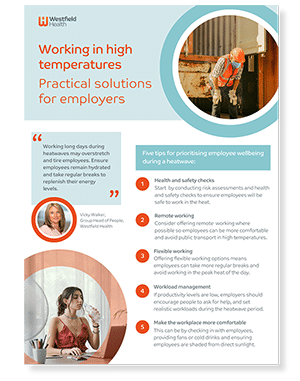UK temperatures continue to rise for another upcoming heatwave and experts warn that heatwaves could become the norm due to climate change. It’s essential for employers to start planning how they will protect and support their workforce during extreme heat.
Employers need to consider practical steps to keep employees safe in high temperatures, including improving workplace conditions, offering flexible working arrangements where possible, and prioritising workforce wellbeing. With more heatwaves expected, employers should prepare clear plans to support employees during extreme weather conditions.
Workplace temperatures: the laws
The UK government has no law for high or low working temperatures, although it’s advised that risk assessments should be carried out. This includes those with health conditions or disabilities that can be affected by extreme temperatures. If conditions affect the health of employees, then they must be suspended on full pay until the risk has ended.
Guidance for employers include keeping work areas at a comfortable temperature and ensuring that there is clean, fresh air for indoor workers. Regular check-ins with employees throughout the day should take place to ensure that temperatures are comfortable.
Heatwaves: the impact on wellbeing
Summertime in the UK is associated with happier, more active people. However, when temperatures rise to an uncomfortable level it can lead to discomfort and be difficult to manage. Some of the key heatwave impacts on wellbeing include:
Lack of sleep and mental health
With temperatures being high through the night, it can disrupt normal sleep schedules with 52% of people struggling to sleep during hot weather. Many people have to weigh up sleeping silently in the heat or sleeping with a noisy fan for better temperature relief. Sleep is when your body and mind rest and recover, making it vital for both physical and mental health. Not getting enough sleep can contribute to mental health challenges and make it harder for people to focus on making positive changes for their wellbeing.
Dehydration in the heat
Exposure to high temperatures can lead to dehydration, which may cause headaches, nausea, dizziness, and muscle weakness. Additionally, working in hot weather can create challenging conditions, leading to discomfort, tiredness, and difficulty concentrating. Office workers should be reminded to have regular water breaks as thirst is not often a sign of dehydration.
For manual workers, the Health and Safety Executive (HSE) recommend drinking around half a pint of cool water every 15 minutes in very high temperatures to avoid heat stress — when the body’s way of controlling its internal temperature starts to fail.
Concentration and productivity dips
The Office for National Statistics (ONS) estimates that £1.2 billion per year is lost due to reduced productivity on hot days (working days over 28 Celsius). High temperatures can lead to dehydration and fatigue, which reduce cognitive function and make it harder for employees to focus on tasks. In physically demanding jobs, high temperatures can slow the pace of work to help prevent exhaustion and heat-related illness. In office settings, poor ventilation or a lack of air conditioning can lead to tiredness and lower motivation.
How can employers look after employees in high temperatures?
Employers should also consider practical ways to help keep workers cool. This can be providing fans or cold drinks, ensuring windows can be opened for fresh air and shading employees from direct sunlight with blinds.
Do a workplace temperature check
It’s vital for employers to assess the situation by conducting risk assessments and health and safety checks to ensure employees will be safe to work in the heat, particularly if any roles involve working outdoors or manual labour, or with employees that have health concerns relating to the heat.
Some steps an include a casual dress code to help employees stay comfortable — particularly in workplaces without air conditioning — as well as regular water breaks and check ins with employees.
Offer remote working where possible
Remote working can be highly beneficial during a heatwave, allowing employees to stay in cooler, more comfortable environments and avoid the discomfort of commuting in high temperatures.
It can be easier for employees to take regular breaks to stay hydrated and cool, supporting both wellbeing and consistent work output during extreme weather, helping them maintain productivity while reducing the risk of heat-related health issues. Although, managers should check in with remote employees to ensure their environment is being managed efficiently and they don’t become overly warm.
Flexible working options
It could be beneficial to employee wellbeing to offer flexible working so the hottest parts of the day can be avoided, and they are able to take regular breaks to hydrate. Employers should consider extending extra flexibility where possible during times of extreme weather.
“Many studies have also shown that changing work patterns can reduce stress and enable employees to fit more healthy habits into their daily routine. This rings true during heatwaves; by being flexible, employees can focus on their wellbeing when they feel too hot or uncomfortable, as opposed to overstretching themselves while working.”
Vicky Walker, Chief People Officer at Westfield Health
Manage workloads
With lower concentration in the higher temperatures, employers can support their team by adjusting workloads and encouraging employees to ask for help when struggling, especially in physically demanding jobs. A smaller, manageable workload is better than risking stress and exhaustion. Managers can also help employees prioritise tasks and break them into smaller steps.
Download our free wellbeing in the heat resource
Our free resource includes five tips on how to look after employees working in high temperatures with practical solutions to support their wellbeing.
